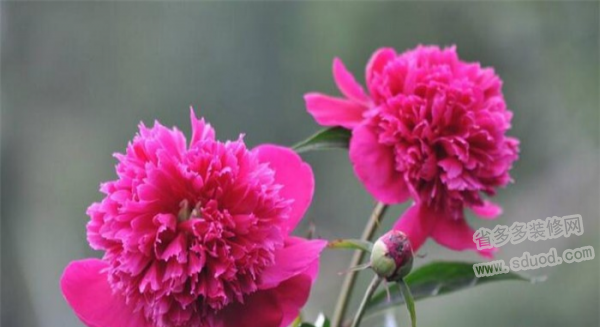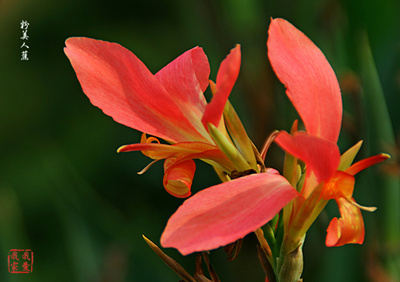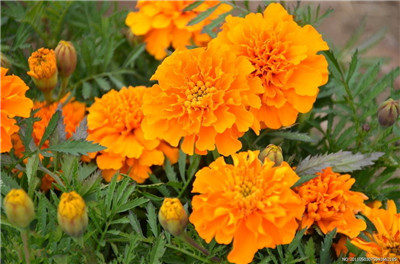How to maintain malachite grass?
The maintenance of malachite can be divided into four aspects: light regulation, temperature control, water and fertilizer management and hybrid management.
The main results are as follows: (1) Light regulation: Peacock grass is a positive plant, which requires sufficient sunlight for growth and flowering, and sufficient light is also beneficial to prevent plant overgrowth. Avoid direct sunlight in the hot season and cool down by shading around noon.
(2) temperature control: the temperature can be reduced by 18 ℃ after potting, to 15 ℃ after a few weeks, and to 12: 14 ℃ before and after flowering. This temperature is ideal for forming a good plant shape, but it may be difficult to achieve this condition in practical production. Therefore, generally speaking, as long as it is more than 5 ℃, it will not be frozen, and it can grow well between 10 ℃ and 30 ℃.

Water and fertilizer
Water and fertilizer are very important to peacock grass. When watering, you need to make sure that the soil is dry before, and then fully water, but be careful not to be too dry. When fertilizing, it is usually possible to apply fertilizer once every 10 days, but it needs to be reduced in the low temperature season in winter. Generally speaking, some base fertilizer should be applied first when planting, and topdressing is needed if the soil fertility is not enough.
Upper basin
Generally speaking, when the young seedlings of malachite grass grow to 2Murray 3 leaves, they need to be put on the pot, and the flowerpots with diameters between 10--15cm can be used when they are put on the pot, and there is basically no need to change the pot after going on the pot.
Diseases and insect pests
The common disease of malachite grass is root rot, which can be controlled by root irrigation with methyl topiramate. Insect pests are mainly red spiders.
Reproduction
The propagation of malachite grass is generally carried out by sowing and cutting. Sowing takes place between November and March. Cutting propagation can be carried out between June and August.
The Propagation method of Malachite
Sowing and propagation of malachite grass
Sowing is a common way for peacock grass to reproduce. When sowing and reproducing, it is usually chosen between November and March. In warmer climates, seeds can be sown all the year round. When sowing, you can use the way of live broadcast, or indoor pot sowing.
The seeds of malachite can be harvested separately and can be sown directly when sowing, or they can be sown in a relatively loose soil as a seedbed. After the sowing medium is sterilized, the seeds can be sown and slightly covered with vermiculite to ensure that the temperature of germination is between 22 ℃ and 24 ℃, which can be germinated in a week. After sowing and growing for a month or so, you can transplant it into the pot.
In addition, it can also be broadcast by itself. The vitality of peacock grass is relatively strong. Generally, if the seeds are not harvested in time, the seeds will fall to the ground and grow on their own under suitable temperature and humidity conditions.
Cutting Propagation of Peacock Grass
In addition to sowing and breeding, malachite grass can also be cut.
The cutting time of malachite grass is mainly in summer and autumn, especially from June to August. Generally, when cutting, the twigs of malachite can be removed, the length is about 10cm, can be cut in the flowerpot, can also be directly cut. After cutting, shading is needed, which has a high survival rate and can be rapidly prototyped.
Peacock grass, which is usually cut in summer, can blossom between August and December.
Matters needing attention in the propagation of malachite
It should be noted that according to different varieties, the time of flowering is also different, generally from sowing to flowering takes about 40 Murray 70 days. Therefore, when sowing, you can choose the appropriate sowing time to make it blossom at the right time.
Note that in the seedling stage, it is necessary to maintain appropriate temperature and humidity to prevent and control diseases and insect pests and plant necrosis.
Culture methods of malachite how to maintain malachite
Culture methods of malachite grass
Light
Peacock grass is a plant that likes light, and it needs plenty of sunlight when raising it. Generally in spring and autumn can meet the needs of peacock grass for light, but should pay attention to avoid direct sunlight in hot summer, but also shade at noon, but do not over-shade.
Temperature
Basically, malachite grass can grow well between 10 ℃ and 30 ℃, and several points that need to be noted are: the temperature in winter should be kept above 5 ℃, so that it is not easy to produce frost injury; before flowering, the temperature had better be kept between 12 ℃ and 15 ℃; during daily maintenance, the temperature had better be kept below 20 ℃ or 20 ℃.
Water and fertilizer
Water and fertilizer are very important to peacock grass. When watering, you need to make sure that the soil is dry before, and then fully water, but be careful not to be too dry. When fertilizing, it is usually possible to apply fertilizer once every 10 days, but it needs to be reduced in the low temperature season in winter. Generally speaking, some base fertilizer should be applied first when planting, and topdressing is needed if the soil fertility is not enough.
Upper basin
Generally speaking, when the young seedlings of malachite grass grow to 2Murray 3 leaves, they need to be put on the pot, and the flowerpots with diameters between 10--15cm can be used when they are put on the pot, and there is basically no need to change the pot after going on the pot.
Diseases and insect pests
The common disease of malachite grass is root rot, which can be controlled by root irrigation with methyl topiramate. Insect pests are mainly red spiders.
Reproduction
The propagation of malachite grass is generally carried out by sowing and cutting. Sowing takes place between November and March. Cutting propagation can be carried out between June and August.
The Propagation method of Malachite
Sowing and propagation of malachite grass
Sowing is a common way for peacock grass to reproduce. When sowing and reproducing, it is usually chosen between November and March. In warmer climates, seeds can be sown all the year round. When sowing, you can use the way of live broadcast, or indoor pot sowing.
The seeds of malachite can be harvested separately and can be sown directly when sowing, or they can be sown in a relatively loose soil as a seedbed. After the sowing medium is sterilized, the seeds can be sown and slightly covered with vermiculite to ensure that the temperature of germination is between 22 ℃ and 24 ℃, which can be germinated in a week. After sowing and growing for a month or so, you can transplant it into the pot.
In addition, it can also be broadcast by itself. The vitality of peacock grass is relatively strong. Generally, if the seeds are not harvested in time, the seeds will fall to the ground and grow on their own under suitable temperature and humidity conditions.
Cutting Propagation of Peacock Grass
In addition to sowing and breeding, malachite grass can also be cut.
The cutting time of malachite grass is mainly in summer and autumn, especially from June to August. Generally, when cutting, the twigs of malachite can be removed, the length is about 10cm, can be cut in the flowerpot, can also be directly cut. After cutting, shading is needed, which has a high survival rate and can be rapidly prototyped.
Peacock grass, which is usually cut in summer, can blossom between August and December.
Matters needing attention in the propagation of malachite
It should be noted that according to different varieties, the time of flowering is also different, generally from sowing to flowering takes about 40 Murray 70 days. Therefore, when sowing, you can choose the appropriate sowing time to make it blossom at the right time.
Note that in the seedling stage, it is necessary to maintain appropriate temperature and humidity to prevent and control diseases and insect pests and plant necrosis.
- Prev

How to spend the winter with canna
Autumn is coming, the temperature is gradually dropping, and the fleshy roots of canna are vulnerable to freezing damage at low temperatures. Therefore, we should make full preparations for overwintering before the coming of winter. According to personal experience, you can survive the winter safely in the following ways. Before and after Frosts Descent, after the ground part of the locally planted canna died, the dead leaves were cut off.
- Next

How to raise peacock grass?
Peacock grass likes the sun, but it can blossom when planted in half-shade. It is not strict with the soil. It is not only resistant to transplanting, but also grows rapidly, and the cultivation and management is easy. The seeds scattered on the ground can grow and grow in suitable temperature and humidity conditions, so it is a kind of flower with strong adaptability. In the south of our country
Related
- Fuxing push coffee new agricultural production and marketing class: lack of small-scale processing plants
- Jujube rice field leisure farm deep ploughing Yilan for five years to create a space for organic food and play
- Nongyu Farm-A trial of organic papaya for brave women with advanced technology
- Four points for attention in the prevention and control of diseases and insect pests of edible fungi
- How to add nutrient solution to Edible Fungi
- Is there any good way to control edible fungus mites?
- Open Inoculation Technology of Edible Fungi
- Is there any clever way to use fertilizer for edible fungus in winter?
- What agents are used to kill the pathogens of edible fungi in the mushroom shed?
- Rapid drying of Edible Fungi

